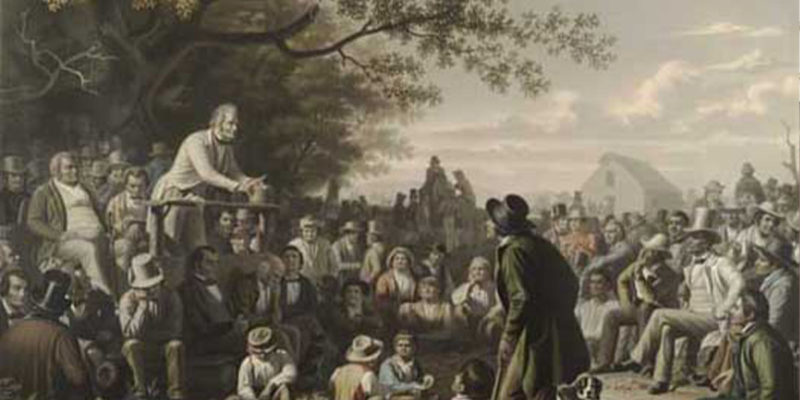Does gerrymandering deserve the awful reputation it has received? Through a revaluation in light of Founding principles, gerrymandering’s hidden virtues are uncovered.
Gerrymandering is often thought to be a sign of a failing American democracy. Perhaps the most detested effect of gerrymandering is how it works to disenfranchise certain voting groups. Gerrymandering may be done through either “cracking” (distributing a party’s support over so many districts that they cannot form a majority to in any one district) or “packing” (a party’s voters are so highly concentrated in a district that they cannot have influence outside of it) (Stephanopoulos 2017). Both methods can effectively disenfranchise voters, concentrating or spreading out votes to weaken the influence of certain electoral groups. The belief that gerrymandering disenfranchises voting challenges the democratic notion that the will of the people must match outcomes in their representation. Popular arguments against gerrymandering have claimed that to achieve democratic fairness, the relationship between the people’s vote and the seat share of a party must be proportional (Mann 2016). Gerrymandering ultimately seems to flout the principle of consent of the governed, a case of democratic ideals being detached from democratic practice.
Yet gerrymandering may actually be advantageous to American democracy. Justifying gerrymandering requires a thorough examination of Founding principles, how they have been subverted since their origin, and ultimately how gerrymandering may restore such Founding principles. There are two paramount reasons for gerrymandering’s philosophical merit. Firstly, it restores an essential principle of the American republic by balancing elite and popular influence. Secondly, it also helps restore a more desirable balance between federal and local government.
It is necessary to recognize the Founders’ belief that a degree of aristocratic refinement was necessary to democracy, and thus that the country was created not as a direct democracy, but rather as a representative republic. The Founders were prudently aware of the fact that a nation founded on both individual rights and the democratic collective will could find itself in moments when these foundational principles could conflict. To rely on the unchecked will of the people (though attractive) could be a possible means of creating a majority tyranny that would destroy the more foundational individual rights that the government was created to protect. As James Madison writes in Federalist 10, “to secure the public good and private rights against the danger of such a faction, and at the same time to preserve the spirit and the form of popular government, is then the great object to which our inquiries are directed.” Madison goes on to state that “A republic… promises the cure for which we are seeking,” whereas a “pure democracy… can admit of no cure for the mischiefs of faction.” With this in mind, the view that gerrymandering is wrong solely due to how it frustrates the democratic will (the standard argument) is undoubtedly insufficient when viewed through the lens of American political thought.
The republic was initially designed so that representation would achieve a careful balance between the will of the people and the independent judgment of certain wise and ambitious elites. From the perspective of the Burkean models of delegate representation (in which representatives legislate solely based on the ideas of their constituents) and trustee representation (in which representatives are entrusted with the liberty to deliberate based on their own beliefs, with the goal of securing the common good), the Senate is based on the trustee model, and the House on the delegate model (Dovi 2017). As stated by Madison, the Senate was to be a bulwark of stability and intelligence (especially against factions) that could counter the populist tendencies manifested in the House and deliberate based on a view of the common good that was more careful and aware of long term considerations.
Yet since the ratification of the Constitution, the phenomenon of convergence between the House and Senate has eroded the careful equilibrium of trustee and delegate representation (Baker 2008, 166). Most notably, the establishment of direct elections for the Senate (the 17th amendment) is largely responsible for the loss of trustee representation. Though the amendment was made not to increase direct representation, but rather decrease the possibility of corruption, it has nonetheless resulted in the reorientation of senators’ priorities toward appealing more and more to the passionate public (Schiller 2014, 9). This includes tangible consequences, such as the fact that senators are increasingly beginning their campaign cycles earlier and earlier, and straying less and less from the views of their constituents (Baker 2008, 185). The result is an enormous gap in the original purpose of the Senate, with no proposed policy as a solution.
It is through the acceptance of certain aristocratic principles that one might view gerrymandering as a restoration of the intended balance between delegate and trustee representation that has been eroded since the Founding. By providing distance between the people and legislation in Congress, gerrymandering can be seen as a valuable measure to check the purely democratic will. It is true that gerrymandering does not function in the exact same way as the pre-17th amendment Constitution did, as gerrymandering does not allow the state legislatures to elect candidates directly. This only means that refinement must come in a different form—one that acquiesces to increased deference to the will of the people as compared to Article I Section 3, while still effectively providing a means to check it.
One example of such a form is gerrymandering’s unappreciated ability to prevent tyranny of the majority. At the time of the Founding, the most feared threat to democracy was the domination by a faction that would subject the common good of the country to its dangerous ends. Though this threat may not be viewed in the same way today, majority tyranny is an intrinsic threat to democracy. Gerrymandering could conceivably prevent the ascent of a tyrannical majority by deliberately weakening the electoral power of a growing faction. Let us imagine, for example, a group of fascists gaining power, and the use of gerrymandering to impede their will. Gerrymandering is a practice that has the potential to serve as a great check and preventive measure on the will of the people by allowing the “enlightened views and virtuous sentiments” of the elected few to create a barrier between the passionate will of the majority and national legislation (Madison 2001).
Another notable strength of gerrymandering is its ability to restore the principles of federalism in electoral authority. Federalism, or the balanced division of authority between the state and national government, was of paramount importance to the Founders. In Federalist 59, Hamilton argued for the importance of balance in electoral authority between state and national governments regarding congressional elections. Though the paper explains the enormous danger of granting full control of congressional elections to the states—as this would “leave the existence of the Union entirely at their mercy”—Hamilton also argues that giving the federal government complete control over congressional elections would leave the states at the mercy of the national government. Hamilton therefore argues for granting the state legislatures partial control over congressional elections, in the form of state legislatures appointing senators (a right granted by the Constitution, pre-17th amendment). Anything else, Hamilton states, “would doubtless have been interpreted into an entire dereliction of the Federal principle.” While true that Hamilton’s argument was that state legislatures would vote for the Senate (not the House), the core of Hamilton’s pursuit of “Federal principle” is that state legislatures ought to have control over one chamber, while the national government ought to have control over the other chamber. And so, by granting state legislatures the authority to influence the outcome of congressional elections, gerrymandering may be seen as a restoration of state legislative influence over national elections. Though not the same form of influence as the state legislature’s direct election of the Senate, gerrymandering is still a striking example of how Federalism in national elections may operate at least to a degree within the existing framework of the laws (Tolson 2010, 877). As the 17th amendment relinquished a significant amount of power to the federal government, gerrymandering can restore the balance of electoral authority between the national and state governments.
Similarly, gerrymandering may be valuable for federalism by refocusing the interest of the people towards state government. As voters have shifted their focus almost entirely to the national level, the state level has become overwhelmingly neglected. This phenomenon poses a difficulty for democracy and its ability to maintain public faith in government. Yet, if the public were to recognize that the composition of the national government is dependent on state government and its ability to gerrymander, voters would recognize the necessity of participating in both the state and national levels of government. While this may not lead to the restoration of the Tocquevillian township, it is nonetheless an example of how to make people revalue government that is closer to home. As it has become too common to hear that someone chooses not to vote because they feel they feel that their voice is unheard in the vast national elections, state legislative elections provide an opportunity for citizens to exercise their democratic will effectively and thereby regain faith in their government.
Gerrymandering may present an obstacle to a healthy republic in the final analysis, but the arguments provided so far have neglected some of the uses of gerrymandering that help strengthen American democracy. We ought not write off gerrymandering too quickly, as it may -in the ways outlined here – provide us with ways to restore and profit from the Constitution which aimed to provide us with constraints to self-government in the service of liberty.
WORKS CITED
Baker, Ross K. 2008. House & Senate. Fourth Edition. New York: W. W. Norton & Company.
Dovi, Suzanne. 2017. “Political Representation.” The Stanford Encyclopedia of Philosophy. Edward N. Zalta (ed.), https://plato.stanford.edu/archives/win2017/entries/political-representation/.
Hamilton, Alexander. 2001. “No. 59.” In The Federalist, edited by George W. Carey and James McClellan. Indianapolis: Liberty Fund Inc.
Mann, Thomas. 2016. “We Must Address Gerrymandering.” Time, October 13, 2016. http://time.com/collection-post/4527291/2016-election-gerrymandering/
Madison, James. 2001. “No. 10.” In The Federalist, edited by George W. Carey and James McClellan. Indianapolis: Liberty Fund Inc.
Schiller, Wendy. 2014. Electing the Senate: Indirect Democracy before the Seventeenth Amendment. Princeton: Princeton University Press.
Stephanopoulos, Nicholas. 2017. “The research that convinced SCOTUS to take the Wisconsin gerrymandering case, explained.” Vox, July 11, 2017. https://www.vox.com/the-big-idea/2017/7/11/15949750/research-gerrymandering-wisconsin-supreme-court-partisanship
Tolson, Franita. 2010. “Partisan Gerrymandering as a Safeguard of Federalism.” Utah Law Review.




 Compass is an online journal that provides a space for the work of talented undergraduates who have original and well-articulated insights on important ideas and issues relating to American democracy understood in the broad contexts of political philosophy, history, literature, economics, and culture.
Compass is an online journal that provides a space for the work of talented undergraduates who have original and well-articulated insights on important ideas and issues relating to American democracy understood in the broad contexts of political philosophy, history, literature, economics, and culture.